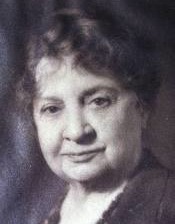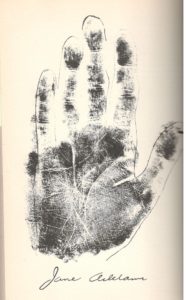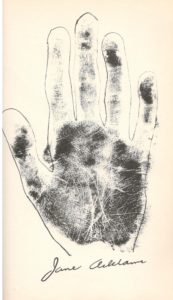Fortune telling, in the forms of reading tea leaves, tarot cards, palms, and crystal ball gazing, have long been popular forms of entertainment. People were and are fascinated to see readings of celebrities, hoping to learn more about them.

Palm readers could become celebrities in their own right, like Nellie Simmons Meier (1864-1944) who built an international reputation as a palmist by insisting that it was a scientific practice rather than an occult hobby. Meier did not tell fortunes–she conducted “character readings”–but she gathered them for some of the most famous people in the early 20th century–Albert Einstein, Margaret Sanger, George Gershwin, Walt Disney, and Jane Addams. Meier organized over 100 palm prints and character readings into chapters in a book, called Lion’s Paws, that she published in 1937.
Addams’ palms were included in the chapter “Can The Leopard Change His Spots?,” along with Norman Thomas, Margaret Sanger, Susan B. Anthony, Ben B. Lindsey, Carrie Chapman Catt, and Jacob Riis. She prefaced the readings with a question:
If a reformer or a radical makes his living in the very work of reform, he is doubly suspect; if he makes no money, he is believed to be seeking notoriety, honor, distinction. Do the hands of reformers and radicals sustain this suspicion?

When Meier observed Addams’ palms she noted both the extraordinary similarities and important differences between her prints and those of Susan B. Anthony’s. Both women, she reported, demonstrated practical and executive ability, appreciation of the arts, and honesty, as well as strong wills and love for others. However, she saw important differences, primarily centering around the reasons that they did what they did.
Addams, Meier claimed, was motivated by the individuals she helped. For her it was not about fame or even about the “common good” as she claimed it was for Anthony. Rather, everything came down to her interactions with individuals, and the justice and mercy served, rather than a more nebulous greater good. It is certainly evident that Addams cared about those around her and wanted to help people–if she had not she probably would not have started Hull House or crusaded for the rights of workers and immigrants.

According to the palm reader, Addams was also a born conservative, cautious about everything. Something that, intriguingly enough, appears to be present in many of her letters, which paint a picture of Addams as a woman who is faultlessly polite and dignified- the very image of a conservative woman.
Is Meier’s character reading an accurate one? It certainly seems to be in line with the Jane Addams in the letters being transcribed. However, this is also information anyone could get just by reading her books and news articles about her. These present a picture of a woman who sounds exactly as Meier described. Of course, it is possible that Jane Addams’ kindness, generosity, and care for others was indeed written in her hand, but perhaps it is more important that it was written in her life.
For more on Nellie Simmons Meier and her character readings, see finding aids to collections of her papers at the Library of Congress and the Indiana Historical Society. For details on her home, see a description of Tuckaway from Historic Meriden Park.
Margaret Szydlik: The Publicity Assistant for the project, she is expected to graduate with a BA in History, with minors in French and Anthropology in May 2017. Her job is focused on the social media associated with the project, updating and maintaining the blog, and garnering public interest in the project, though she is also involved in the transcription of the documents. She can be contacted at mszydlik@ramapo.edu.

